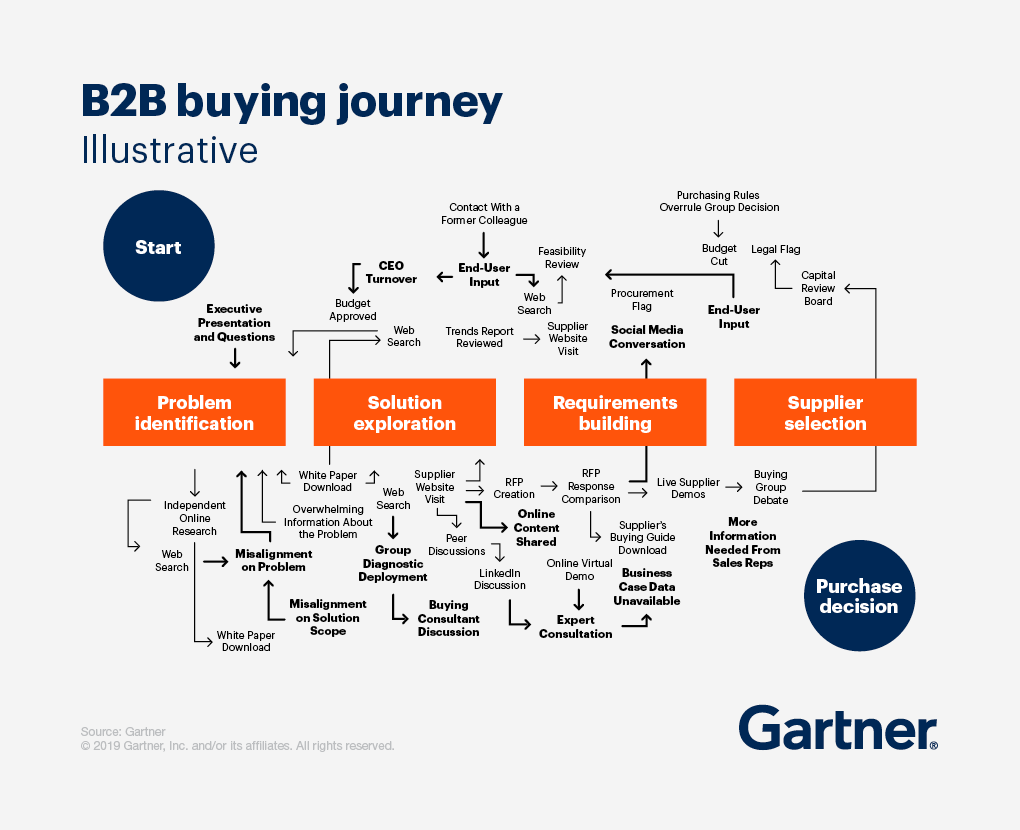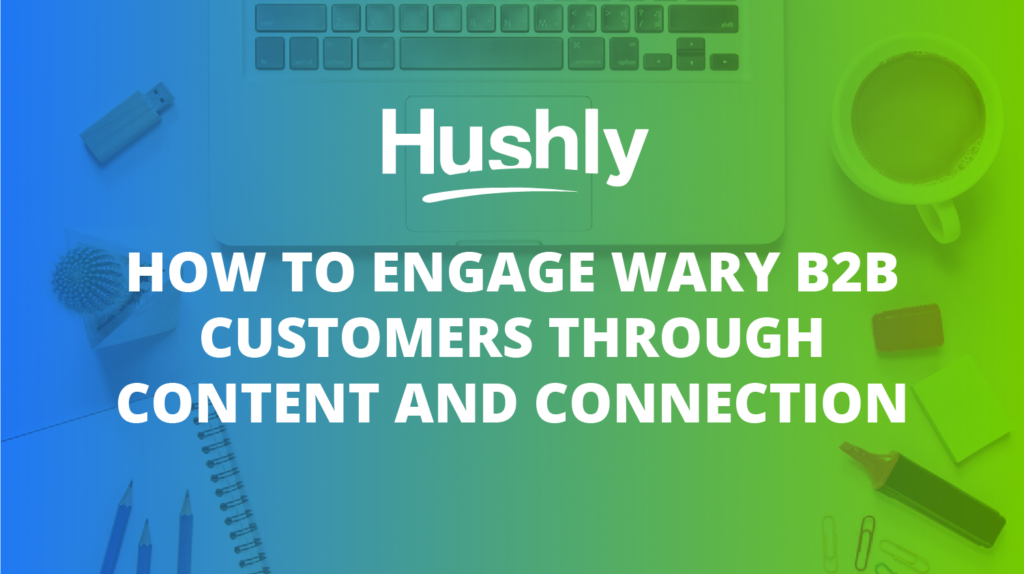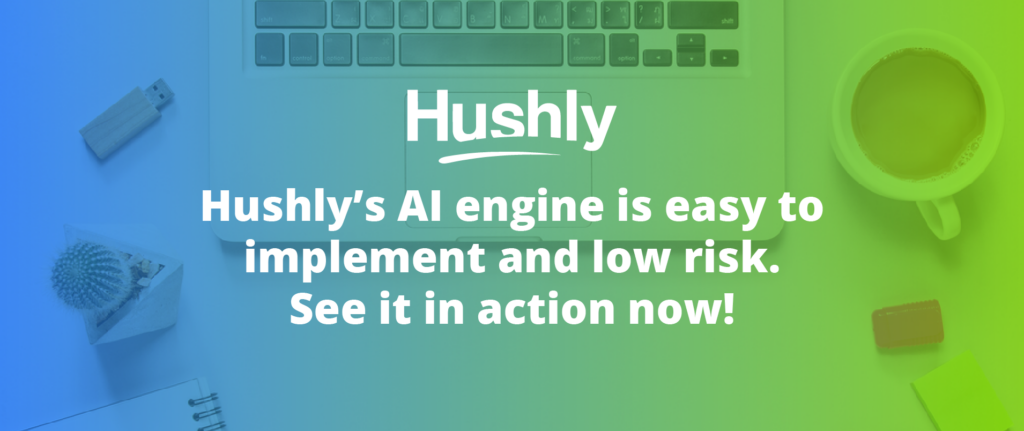Your B2B buyers don’t rely on sales teams for research anymore.
Years ago, sales teams had the information buyers needed to make informed decisions. The buyer’s journey was at least somewhat linear and followed a clear path.
Today’s buyers are empowered with endless knowledge at their disposal. Here’s what they’re journey looks like, according to Gartner:

Despite this, many B2B sales and marketing teams are stuck in the past. They focus on lead generation, passing those leads off to sales, and enlisting sales teams to hound them until they convert.
That strategy only drives leads away.
Instead, you need to understand that most of your prospects and leads are NOT ready to buy – and might not be for quite a long time.
Use your knowledge and skills and put it to work helping your leads and prospects. The tactics below can help you engage B2B customers without resorting to outdated salesy strategies.

How to Engage Your B2B Customers at Every Stage: 5 Tips
What’s the key to learning how to engage B2B customers? Research and technology.
Those tools help you create winning content and deliver the right asset to every prospect or lead at the perfect time.
1. Develop Unique Buyer Personas
Buyer personas are your roadmaps for engaging B2B customers. When executed right, your buyer personas should tell you everything from:
- What job role they’re in
- Who they report to
- Role in the buying process
- Where they hang out online
- Which blogs they read
- Their major pain points
It’s smart to take an account-based marketing approach when you develop your buyer personas. Start with firmographic data like:
- Company name
- Company size and market share
- Location and region
Even if you don’t plan to launch a specific account-based strategy for every persona (although with the tech available, there’s no reason you can’t), these details will give you a better picture of your target audience.
Using information from your buyer personas, you’ll be able to create the most relevant and useful content possible for your audience segments.
2. Create Multiple Types of Content
This should play into your buyer persona development, but it really deserved its own section for our purposes here.
Content is vital with the average B2B customer consuming 13 different pieces of content before making a decision – eight of which come from the specific vendor’s website.
Each segment of your audience wants to consume distinct types of content. Which type should you create? It depends. Blogs and videos are safe bets. However, you also have infographics, eBooks, podcasts, whitepapers, case studies, and more.
- 67% want content on functionality.
- 65% want product comparisons.
- 60% want success stories and case studies.
- 54% need content that proves value to stakeholders.
- 49% want tutorials.
- 48% want how-to blogs.
This is another reason it’s so important to engage with people in your target firmographics on social media. Look at what type of content they share and from what places.
3. Use AI to Personalize Your B2B Customer Experience for Each Visitor
Creating content is only half the battle. You still must figure out how to get it in front of the right people at the perfect time.
Artificial intelligence removes that problem to create the ideal website experience. AI has skyrocketed in use by 186% since 2018. Long a mainstay in giants like Amazon and Facebook, AI engines are now accessible to businesses at all levels.
By implementing an AI engine on your website, you can deliver a personalized content experience for every visitor – whether known or anonymous.
Hushly’s AI engine, for example, layers multiple algorithms that carefully study behavior and adjust via machine learning to improve over time. Just like Amazon or Pinterest, the longer you run Hushly’s AI engine on your site, the better it gets at recommending content.
4. Swap Your Perspective to Human-to-Human
At the end of the day, remember you’re marketing to human beings. Yes, they’re part of a team but there’s always a single person on the other end of the screen.
Everyone is spending more time than ever online. With so many people working from home these days, work-life is becoming a blur.
Make sure to keep your messaging and conversations relatable. People still crave human connection and that need isn’t going anywhere.
5. Focus on Nurturing
Lead nurturing is critical. The average B2B conversion rate for a PPC campaign is about 2%. In other words, 98% of people who visit your site are not ready to buy.
That’s not a dire situation – it’s an opportunity. Lead nurturing takes many forms and should involve an omnichannel presence.
- Self-nurturing landing pages: Most landing pages serve a single purpose with one CTA and then abruptly end the conversation. With most people not ready to buy, this isn’t the best strategy. Instead, use self-nurturing landing pages with machine learning to offer personalized content recommendations that gently nudge visitors down the funnel with relevant case studies or eBooks.
- Email marketing campaigns: With so much technology available, there’s really no reason not to personalize your email marketing campaigns. Triggered campaigns (sent out when a subscriber completes an action like clicking a link) are easy to set up and deliver 46% open rates on average.
- Social selling: Most B2Bs could stand to do a little less broadcasting and be a little more conversational on social media. Follow your leads and prospects on LinkedIn and Twitter to share valuable links, tips, and content. Don’t even think about converting them into customers. Just focus on helping and talking.
AI Isn’t Optional Anymore
Roughly half of all B2B marketers plan to increase their use of AI technology over the next year, with a whopping 84% already using it in some fashion.
Adding an AI engine to your site delivers the hyper-personalized content experience your visitors expect. Plus, the longer visitors stay on your site, the more content they’ll consume – leading to more qualified leads and better analytics.
Hushly’s AI engine is easy to implement and low risk. See it in action now!

